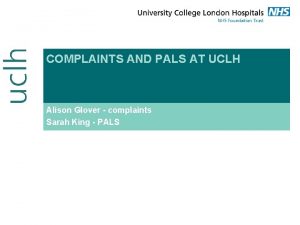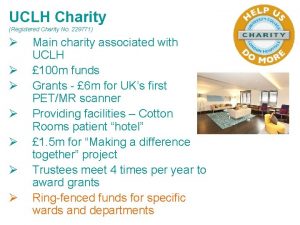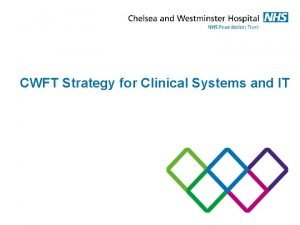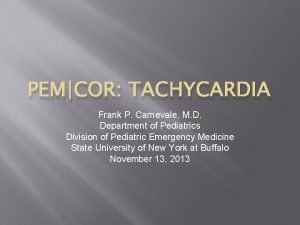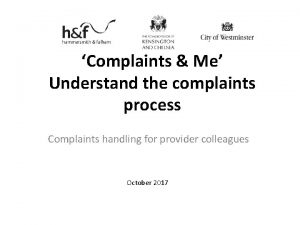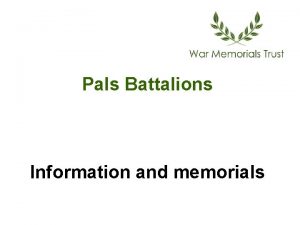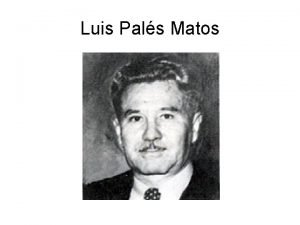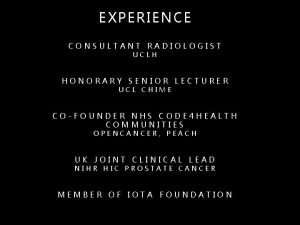COMPLAINTS AND PALS AT UCLH Alison Glover complaints














- Slides: 14

COMPLAINTS AND PALS AT UCLH Alison Glover - complaints Sarah King - PALS

RESOLVING PATIENTS’ CONCERNS Two teams working closely together and with trust departments to resolve patient concerns and improve services where necessary PALS § Role is to provide general advice on UCLH services, sometimes NHS services/structure (referrals etc), and to resolve issues patients by liaising with the relevant clinical teams. § Focus is on speedy resolution of patients’ concerns COMPLAINTS § A formal process following complaints procedures laid down by the Department of Health § Explicit processes and targets including external independent review by the Parliamentary Health Service Ombudsman

COMPLAINT PROCESS § § § § § Complaint received (via e. g. CEO's Office, Trust website) Sent to central complaints team & assessed for risk / severity Registered on 'Datix' Sent to lead division for investigation (copied to others, eg CN) Telephone call to complainant to discuss complaint, approach to investigation & timescales Investigation conducted Response prepared Sent to central complaints team, quality checked CEO covering letter drafted & complaint sent to CEO for sign off

NUMBER AND TYPES OF COMPLAINTS AND CONCERNS Pals handled 3, 378 cases in 2013 and approximately 4, 200 quick enquiries 665 formal complaints received in 2013 Types of concerns: § Access issues § Administration / letters § Environment / food § Attitudes § Nursing / medical care § Clinical outcome

HOW COMPLAINTS & CONCERNS ARE USED TO IMPROVE SERVICES Focus is on improving services to ensure future patients do not have similar problems § § Learning for individuals eg attitude / competency Subspecialty or departmental changes Capturing themes / triangulation of data Sharing learning across a division / the Trust

EXAMPLES OF SERVICE IMPROVEMENTS § § § The introduction of divisional Quality and Complaints Officers to act as first point of contact for PALS and Complaints The option of 'no treatment' must be explicitly discussed and documented during the consent process – revised UCLH consent policy Development of clinical guidelines e. g. use of analgesia in the Emergency Department

SERVICE IMPROVEMENT AT LOCAL LEVEL § § § Complaints about the latent phase of labour progressing more rapidly than expected after initial assessment (It happens everywhere, and can result in “BBA” – birth before arrival!) The action: A tighter management protocol The creation of “the Nest” – a place to sit it out in the Maternity Care Unit

UCLH Charity and Friends of UCLH Rachel Wilcox, Manager, PR and Discretionary Funds

Patient and Public Involvement (PPI) in service improvement Sameen Malik, Patient and Public Involvement Lead

What is PPI and why should we do it? • Gives people a say in how we do things at UCLH • It helps us to: − Ensure services meet patient needs − Identify areas for improvement − Connect better to patients − Monitor our progress − Fulfil our legal requirement!

What improvements have we made from PPI? It might not always be easy to make changes… but you may help us to identify things we hadn’t thought about that can really make a difference Positive experience, but couldn’t find their way to imaging Patient with visual impairment Route card to help patients find their way

What improvements have we made from PPI? It might not always be easy to make changes… but you may help us to identify things we hadn’t thought about that can really make a difference Interviews revealed this was due to overhearing conversations in the next bay Patients felt staff sometimes talked as if they weren’t there Confidential warning sign on curtains was introduced

How can you get involved? • Let us know of your areas of interest − Tell us if you are happy to commit to something on-going or just as a one-off • We will contact you when projects in your interest area come up Ros Waring Sameen Malik

Volunteers Andrea Kennedy, volunteer and patient governor
